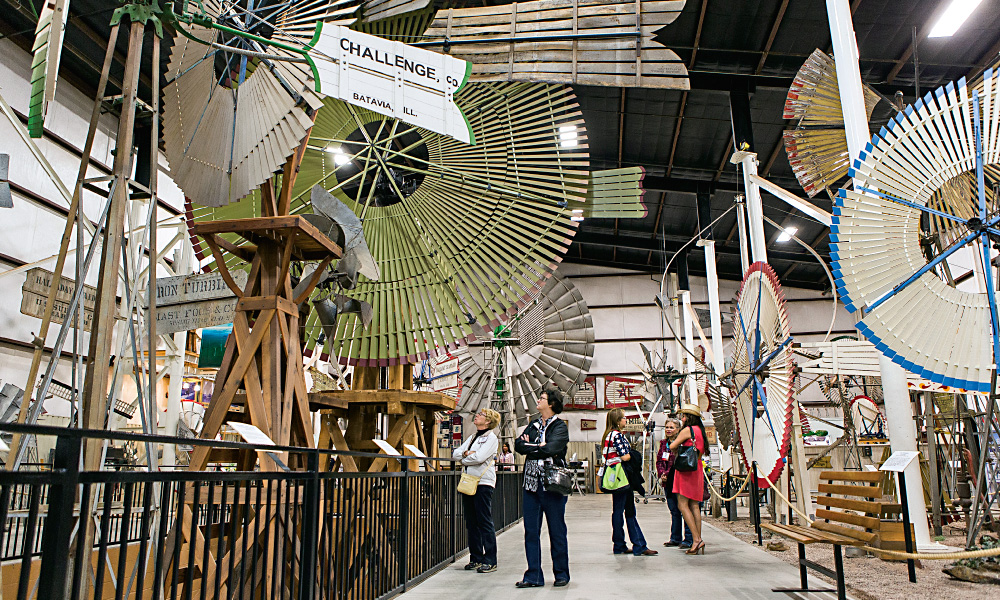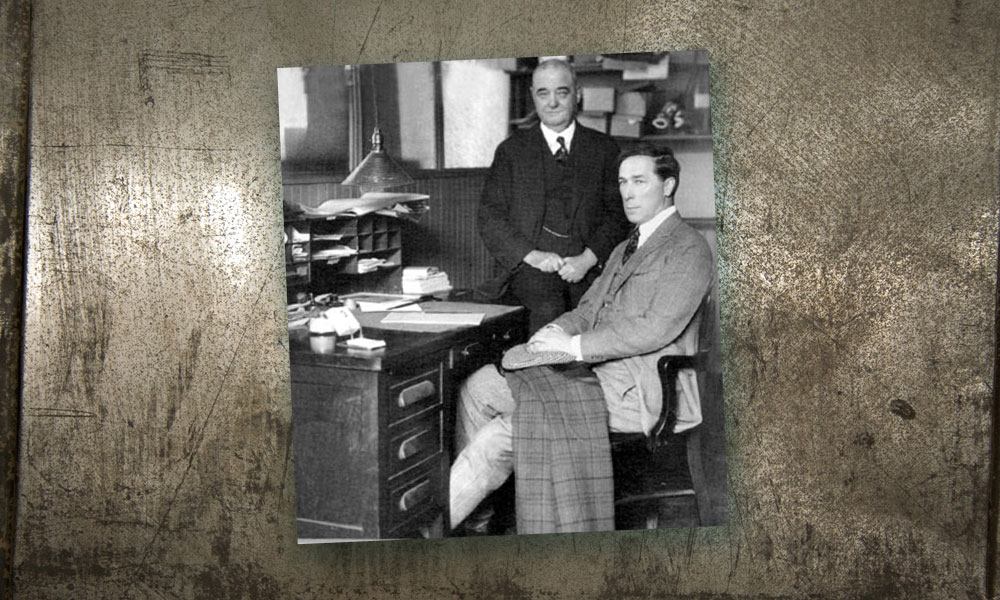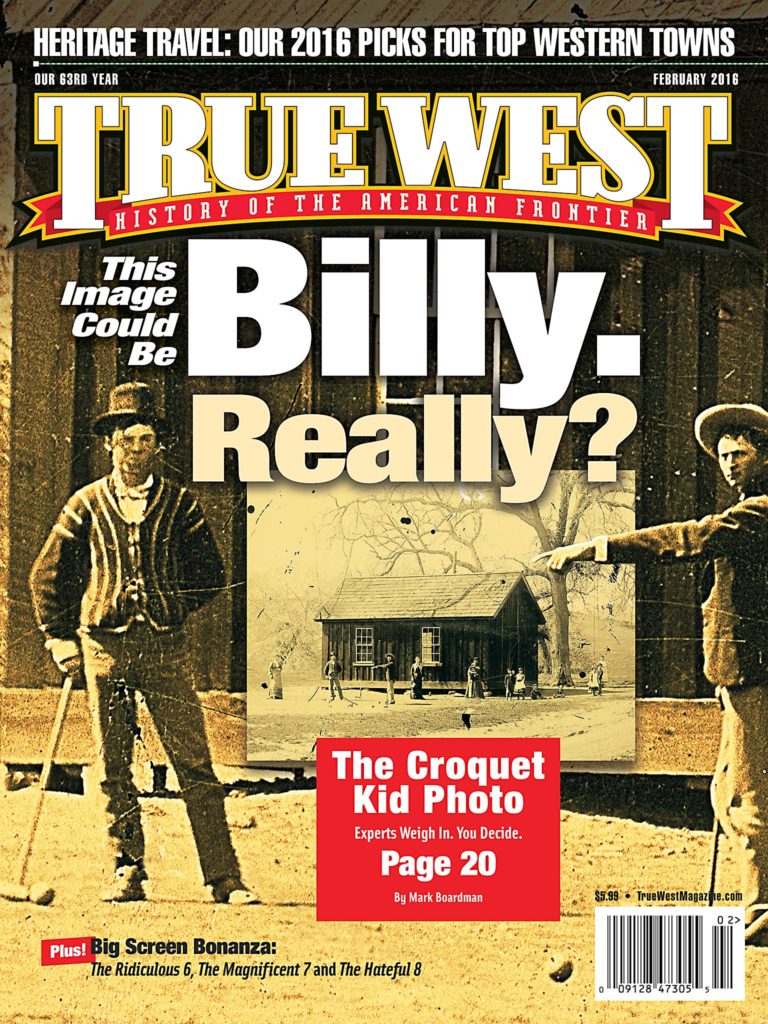
– Courtesy Visit Lubbock –
Don’t lie awake worrying that our history has been forgotten. After compiling this list of great Western towns, we know it’s in good hands.
Across what once was a boom-and-bust landscape, we found a stable network of historians, curators, preservationists, tour guides and old-fashioned history buffs who work hard to tell the story of the American frontier, which, after all, is the story of us as a unique people and culture. Early Westerners gave us much to ponder.
But in the end it’s about hitting the road to visit great people in great towns in the still-
great—though slightly less wild—West.
We dedicate our list to everyone who loves a frosty sarsaparilla, wooden plank sidewalks, Old West gunfights and big, melodramatic hats.
#1 Lubbock,TX
How could we not love a town named for a Texas Ranger? Set on the west Texas Plains, Lubbock grew quickly after the Santa Fe Railroad arrived in 1909, earning it the nickname “Hub of the Plains.”
Don’t miss the National Ranching Heritage Center at Texas Tech University. The site features six museum galleries, 38 pieces of outdoor bronze art and 48 authentic relocated ranch buildings.
“They date from the 1700s to the 1950s, and tourists love walking through the site to see how people lived in those times,” says Alyssa Kitten of Visit Lubbock. The center also hosts the annual National Cowboy Symposium & Celebration, a festival of art, music, horse-handling and more.
Lubbock has trolley tours of a vibrant downtown cultural district. The Bayer Museum of Agriculture highlights early farm life, and the Silent Wings Museum preserves the story of World War II’s glider pilots. Smithsonian magazine named Lubbock Lake National Historic Landmark, an archaeological preserve, one of the five best places to see evidence of the first Americans.
Rock ’n’ roll fans love the Buddy Holly Center, named for the legendary singer killed in a 1959 plane crash. His glasses, recovered from the crash, are displayed.
Unsung hero: Home economics teacher Billie Wolfe created the American Wind Power Center, which holds the world’s largest collection of windmills. Settlers couldn’t survive on the plains without pulling water from the ground.
At the Heritage Center, be sure to see the Writers of the Purple Sage exhibit about authors who brought us the true West in words, and its display of lever-action rifles, which kept settlers alive to read those writers’ works.
Few towns of 240,000 have demonstrated such a long commitment to preservation of its Western past, and for that reason, we name Lubbock our number one True Western Town for 2016.
#2 Dodge City, KS
Few towns are more famous than this former cattle railhead where Texas drovers butted heads with legendary lawmen. Founded in 1872, a contemporary Kansas newspaper editor wrote that Dodge City was “a synonym for all that is wild, reckless and violent; hell on the plains.”
At Boot Hill Museum, located at the original Boot Hill Cemetery, visitors can walk among the headstones, have a beer at the replica Long Branch Saloon and stroll Front Street, a reconstruction of its 1876 version.
The museum holds a 250-gun collection, including a Colt believed to have been Bat Masterson’s. How about a Sharps-Creedmore 1869 buffalo hunter’s rifle, the owner’s name inlaid in silver? “During hunting season, we have guys standing around talking about our guns for hours,” says curator Karen Pankratz.
Wyatt Earp gets his due with a bronze statue across from the Santa Fe train depot, restored to its 1898 look. A separate bronze depicts Doc Holliday playing cards. Where else would folks rush to have their picture taken beside a tubercular dentist?
Take a trolley tour of historic sites and step inside the 1881 Mueller-Schmidt house, with 22-inch-thick limestone walls and period furnishings.
Don’t miss summer’s biggest bash, Dodge City Days. Tourists watch as cowboys on horseback ramrod actual longhorn cattle down Wyatt Earp Boulevard.
Step carefully, tinhorns!
#3 Buffalo, WY
Fans of the show Longmire, based on the novels of Johnson County resident Craig Johnson, will love this easygoing town under the Big Horn Mountains.
In some ways, the West of our dreams started here with Owen Wister’s 1902 novel, The Virginian, which invented the iconic cowboy hero. He based some characters on the saddle tramps and derby darlings he observed at the saloon in the Occidental Hotel, an area hub since 1880.
Wyoming’s oldest operating hotel—also a museum—retains its Old West charm, with embossed ceilings in the lobby and saloon. The 1903 Mansion House Inn has hand-carved oak mantles and original leaded-glass windows. Don’t miss the Jim Gatchell Memorial Museum, home to 26,000 items from the lives of settlers and American Indians.
Take a drive to Fort Phil Kearny and the TA Ranch, a working spread and guest ranch where the last bloody fight of the Johnson County War occurred.
The site of the 1866 Fetterman Massacre is nearby, and the Mountain Plains Heritage Park allows visitors to learn the region’s history while enjoying the outdoors.
For a community of 4,600, Buffalo is a true Western showcase. In Wister’s famous line: “When you call me that, smile!”
#4 Prescott, AZ
In American history, Prescott is the only Territorial capital founded in what was then an empty place, without buildings, roads—nothing existed. But gold gleamed in its creeks.
As historian and tour guide Melissa Ruffner explains, the military didn’t want Confederates grabbing the yellow metal, so Prescott, in 1864, became a capital among the juniper trees.
Today, this jewel in the Bradshaw Mountains boasts 809 buildings and other items on the National Register of Historic Places. Several noteworthy buildings stand along Whiskey Row, opposite Courthouse Plaza. It once had 40 saloons and Doc Holliday. In 1879, he gambled there before leaving for Tombstone and legend.
The oldest building associated with Arizona Territory, the log cabin that served as the first governor’s mansion, stands at Sharlot Hall Museum.
Two other fine museums: The Phippen celebrates cowboy artists and the Smoki focuses on the region’s original Native American residents.
Don’t miss the beautiful homes lining Mount Vernon Street. Ruffner, who was born in one of those stately Victorians, always takes visitors there.
Prescott Frontier Days honors the town’s past every July 4th with a parade and rodeo, begun in 1888 as a Cowboy Contest.
A hidden treat: Have a drink on the second-story balcony of the Jersey Lilly Saloon, high above the yippee-ki-yay of Whiskey Row.
#5 Fort Smith, AR
Memorialized in the movies Lonesome Dove and True Grit, the so-called gateway to the West has a lawless past that’s unmatched. So was the fierce justice of Isaac Parker, the local hanging judge.
Exhibits at Fort Smith National Historic Site include two jails, Parker’s courtroom and the gallows that dispatched 86 souls between 1873 and 1896. On execution anniversaries, rangers tell of each prisoner and hang a noose on the gallows in remembrance.
Fort Smith has, as one observer remarked, “a wonderful habit of history”—evident at the Fort Smith Museum of History, a trolley museum, an aviation museum and, opening to great anticipation next year, the National U.S. Marshals Museum.
At a former bordello—Miss Laura’s Social Club—tourists see a “working” bedroom from 1910 and period costume gowns displayed in Miss Laura’s room. They’re among the town’s most photographed items, says Carolyn Joyce of the convention and visitors bureau.
For 23 years, tourists have enjoyed her portrayal of a gussied-up Miss Laura. “I had my picture taken with a minister this morning,” says Joyce with a wink in her voice. “He’s going to put it in his church bulletin.”
Miss Laura’s old bordello now houses the visitors’ bureau—still drawing them in after all these years.
#6 Amarillo, TX
The Yellow Rose of Texas began along a railroad line and grew into a cattle-shipping center. Today, the Panhandle’s largest city earns its slogan—For the West of Your Life.
Attractions include fine museums like the American Quarter Horse Hall of Fame and Museum, honoring the horse that drove longhorns across the plains. The Kwahadi Museum of the American Indian has pueblo and Plains Indian artifacts, with the paintings of Thomas Mails, who helped Kevin Costner make Dances with Wolves.
The Panhandle-Plains Historical Museum displays murals of plains life. Palo Duro Canyon, settled in 1876 by cattleman Charles Goodnight, is now a state park offering horseback riding in a beautiful place.
Annual events: The Amarillo Farm & Ranch Show, the Cowboy Mountain Shooting Association Tony Lama World Finals, and the WRCA World Championship Ranch Rodeo. The latter inspires a sing-along to George Strait’s rodeo anthem, written by Terry Stafford and Paul Fraser, “Amarillo By Morning”:
They took my saddle in Houston, broke
my leg in Santa Fe.
Lost my wife and a girlfriend
somewhere along the way.
Well I’ll be looking for eight when they
pull that gate,
And I’m hoping that judge ain’t blind.
Amarillo by morning, Amarillo’s on my mind.
#7 Pinedale, WY
Notice the sun-battered faces and big Stetsons on the cowboys and outfitters still walking the streets, back-curtained by the beautiful Wind River Mountains. These modern figures mirror the mountain men who gathered in this wild country in the 1830s.
The four-day Green River Rendezvous preserves that history through re-enactments, fur trade lectures and more. The Museum of the Mountain Man furthers the theme with exhibits and artifacts like Jim Bridger’s 1853 rifle and a Sioux chief’s buffalo-hide tepee.
North of town, at Sommers Homestead Living History Museum, see a 100-year-old log house furnished as it would have been by pioneers. The New Fork Crossing is an historical park with interpretive walking trails under tall cottonwoods.
Take a walking tour of downtown, where most buildings date to the early 1900s. The Cowboy Shop sells authentic gear, from spurs and slickers to felt-hat stiffener. (Finally! We’ve been looking everywhere.) The owner displays Western antiques, Navajo bracelets, beadwork and old cowboy boots and hats.
On the don’t-miss list, says Maureen Rudnick, Pinedale’s travel and tourism coordinator, is Fremont Lake, 12 miles long, 696 feet deep, named for Western explorer John C. Fremont. “It’s pristine and incredibly beautiful,” she says. “No photograph does it justice.”
#8 Lincoln, NM
If your town has only one street, make it a doozy. Lincoln accomplished that when President Rutherford Hayes called its lone byway “the most dangerous street in America.” He was referring to the bloody Lincoln County War and Billy the Kid, its infamous gun hand.
Today, Lincoln has 50 residents and a remarkable record of preservation. It boasts eight museums focusing on frontier history and 17 historic buildings preserved as they were in the late 1800s, down to the color of the adobe and pitch of the roofs.
The 1877 Tunstall Store has original 19th-century merchandise on its shelves. Exhibits at the 1873 Murphy-Dolan store and courthouse tell of Billy’s murderous escape. So does the annual Last Escape of Billy the Kid Pageant, which last year drew 12,000 people.
To see a frontier Catholic church, visit the San Juan Mission. The village’s oldest structure is the Torreon, a rock tower built by Spanish settlers in the 1850s for protection against Apaches.
But Billy’s the eternal draw. Why do we still chase this charming outlaw? It’s the romantic mystique, says Gary Cozzens, park manager of Lincoln State Monument, “coupled with the fact that there’s much more we don’t know about him than what we do.”
#9 Scottsbluff/Gering, NE
Standing 800 feet above the North Platte River, Scotts Bluff was a landmark for emigrants on the Oregon Trail between 1843 and 1869. Today, it serves the same purpose for visitors following in their footsteps.
Scotts Bluff National Monument tells the story of these pioneers who headed into the unknown in covered wagons. At the visitors’ center, tourists can visualize the experience through the art and photography of William Henry Jackson, who worked as a bullwhacker on a wagon train in 1866.
Leaders in the adjoining towns of Scottsbluff and Gering are dedicated to honoring the area’s history—at Legacy of the Plains Museum, Chimney Rock National Historic Site, and Robidoux Pass National Historic Landmark and Trading Post, built in the 1840s. A replica of hand-hewn logs looks as it did when men hunted for “soft gold”—fur pelts.
The Oregon Trail Days Celebration honors settlers with a Western art show and other activities. Last year’s Old West Balloon Fest, held against a beautiful fall landscape, drew 12,000 people.
Insider tip from Brenda Leisy, director of tourism for Scotts Bluff County: Hike to the top of the bluff at sunset. “The views are absolutely stunning,” she says. “Omaha got the population, but we got the beauty.”
#10 Florence, AZ
In 1886, farmers supplying food to military outposts founded Florence, one of Arizona’s oldest towns. Lynn Smith of the Pinal County Historical Museum says the preservation-minded community has 140 historic buildings and a largely adobe commercial district.
Driving into town, notice the cupola of the 1891 courthouse rising against the
sky. The landmark underwent renovation in 2012. “When they first built it, they went all out to impress people Back East that we deserved statehood,” says Smith. “It’s a beautiful red-brick Victorian in the middle of an adobe town. We fought like crazy to save it.”
Step into the courtroom, site of the trial of cigar-chomping female bandit Pearl Hart. The older courthouse, built in 1878, houses the chamber and visitors’ center and McFarland State Historic Park.
With the state prison here, the county museum displays 28 nooses used in hangings and a one-of-a-kind collection of furniture made of saguaros.
Hike atop Poston Butte to the pyramid tomb of Charles Poston, father of Arizona, or drive 40 minutes to ponder the West’s greatest gold legend at Lost Dutchman
State Park.
Guess where Tombstone Epitaph founder John Clum lived before meeting Wyatt? His historic 1878 home is in Florence, which is celebrating its 150th anniversary this year.
Leo W. Banks is an award-winning writer based in Tucson. He has written several books of history for Arizona Highways.





